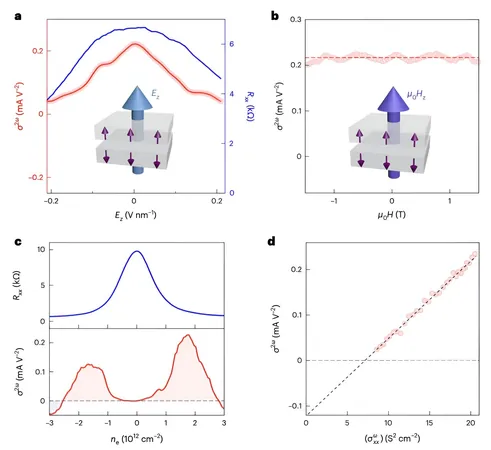
Groundbreaking Discovery: Researchers Unveil Antiferromagnetic Diode Effect in MnBi₂Te₄, Paving the Way for Advanced Technologies!
2024-09-22
In a thrilling advancement within the realm of condensed matter physics, researchers from Harvard University have recently reported the observation of an antiferromagnetic diode effect in even-layered MnBi₂Te₄. This discovery marks a significant leap in the study of antiferromagnets—materials where adjacent atomic magnetic moments are aligned oppositely, rendering them with no net macroscopic magnetism.
Antiferromagnets are attracting growing interest due to their unique properties, which are advantageous for developing next-generation electronic and spintronic devices. The newfound diode effect in MnBi₂Te₄ could potentially revolutionize technologies such as in-plane field-effect transistors and devices that harness microwave energy.
Published in the prestigious journal Nature Electronics, this research builds upon existing knowledge of diode effects in various materials, allowing electrical current to flow uni-directionally in devices. Historically, these diode effects have been integral in developing indispensable technologies, from radio receivers to digital circuits and temperature sensors.
While the spotlight has been on superconducting diodes in non-centrosymmetric materials, this latest research unveils a similar phenomenon occurring within a centrosymmetric crystal structure—an intriguing finding given its implications for future electronics. The team, led by researchers Anyuan Gao, Shao-Wen Chen, and their colleagues, successfully fabricated devices using MnBi₂Te₄ configured in two distinct electrode arrangements: traditional Hall bar electrodes for conductance measurements and radially distributed electrodes designed in a circular pattern.
Their experimental results showcased nonlinear transport characteristics indicative of the antiferromagnetic diode effect in both device configurations. With rigorous testing, they confirmed their groundbreaking observation, marking a new era in materials science.
Utilizing advanced techniques, including spatially resolved optical methods and electrical sum frequency generation (SFG) measurements, the researchers meticulously analyzed the properties of the material, revealing substantial second-harmonic transport. This nonlinear electronic behavior, enabled by the unique compensated antiferromagnetic state of MnBi₂Te₄, suggests vast potential applications.
The authors assert that their findings could catalyze the development of innovative antiferromagnetic logic circuits, efficient microwave harvesters, and cutting-edge spintronic devices. As the research community gears up for more exploratory studies, the antiferromagnetic diode effect offers a tantalizing glimpse into a future rich with possibilities for high-performance electronic devices that may surpass current technologies.
In summary, the revelation of the antiferromagnetic diode effect in MnBi₂Te₄ opens new doors for advancements in electronics, promising to reshape our understanding of materials at the quantum level and leading us toward a more efficient, technology-driven world. Buckle up for what’s next, as this breakthrough could set the stage for a new frontier in electronics and quantum materials!


 Brasil (PT)
Brasil (PT)
 Canada (EN)
Canada (EN)
 Chile (ES)
Chile (ES)
 España (ES)
España (ES)
 France (FR)
France (FR)
 Hong Kong (EN)
Hong Kong (EN)
 Italia (IT)
Italia (IT)
 日本 (JA)
日本 (JA)
 Magyarország (HU)
Magyarország (HU)
 Norge (NO)
Norge (NO)
 Polska (PL)
Polska (PL)
 Schweiz (DE)
Schweiz (DE)
 Singapore (EN)
Singapore (EN)
 Sverige (SV)
Sverige (SV)
 Suomi (FI)
Suomi (FI)
 Türkiye (TR)
Türkiye (TR)